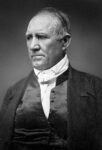Many of the first European settlers of Lancaster County (originally part of Chester County) came to this part of the world to escape religious persecution. Among these were the French Huguenots with names like Feree, Lefevre, and Leman. Others were the Swiss-German anabaptists named Herr, Funk, Bowman, and Kendig. Still others were Scotch-Irish protestants escaping hardships in Scotland and Ireland. One of these early settlers was John Houston, who brought his family to Penn’s Woods and settled along the Pequea Creek in the early 1700s. This is his story.
John Houston was one of the early Scotch-Irish settlers in Lancaster County. He took out a patent for 430 acres in Leacock Township in the Pequea Valley in 1720-21. By the time of his death in 1769, he had expanded that tract to 1,000 acres. Houston bought a mill property along the Pequea Creek from William Blythe in 1751. He built a new mill on the site in the following year.
A devout Presbyterian, Houston helped to organize the Pequea Presbyterian church. In 1741, the evangelist George Whitefield visited the Presbyterian churches in eastern Pennsylvania including the church at Pequea. Houston and some others did not accept Whitefield’s teachings and seceded from the church, creating their own church. In his will, Houston left 100 pounds to the church for its support.
He and his wife, Martha Stewart Houston, raised six sons and two daughters. John lived in the Pequea Valley until his death in 1769. Their oldest son, John, graduated from the University of Edinburg, Scotland and came back to the colonies where he served as a surgeon in the Revolutionary war.
The second son, James, inherited the mill property after his father’s death. James later joined the Continental Army and was promoted to the rank of Captain. James died in the battle of Paoli (September 7, 1777). In 1778, Colonel David Watson issued a notice to local farmers ordering them to send all their wheat, beyond what they need for their immediate families, to James Houston’s mill to be converted into flour for the use of General Washington’s army.
John and Martha’s daughter, Jean Houston, married the Rev. James Proudfoot. Proudfoot was the minister of the Pequea “seceder” church and owned a farm along the Pequea Creek. Their other daughter, Ann, married Thomas Johnston and settled in Franklin County. The third son, Daniel also emigrated to Franklin County and later to Washington County.
The fourth son, William Houston, married Jane Watson, the daughter of Col. Watson. William inherited the original 430 acres, with the conditions to take care of his mother during her life. In 1788, William Houston sold his farm along with 150 acres of woodland near the Welsh Mountain to John Hurst. William and Jane then emigrated to Trumbull County, Ohio.
The fifth son, Thomas Houston, emigrated first to Virginia and then to Tennessee. His son, Samuel Houston, went to Texas where he, as a colonel, took an active part in the Texas revolution. Later, as General Sam Houston, he defeated General Antonio Lopez de Santa Anna at the battle of San Jacinto (remember the Alamo?). The town of Houston Texas is named in his honor.

The sixth son, another Samuel Houston, inherited 230 acres from his father. This property came into the possession of the Hershey family. Hershey’s Mennonite meeting house is on this land. Samuel Houston purchased a large farm on the Philadelphia Pike a short distance north of Gap on the Pennsylvania Railroad. Here he built a stone house and barn and kept a store and tavern. Samuel held the office of Justice of the Peace for many years. In 1829, he was elected to the State Senate.
The Houston mill later became the Hess mill, also known as the New Milltown mill. This mill still stands where the Newport Road crosses the Pequea Creek just below Pequea Valley High School. (The current structure was built in 1800 by Christian Hess.) A small stream that begins west of Gap, runs past the White Chimneys estate, and joins the Pequea just below the New Milltown Mill is still called the Houston Run.

The information for this article came from a newspaper article by J. Watson Ellmaker printed in the Lancaster Intelligencer on March 18, 1908.